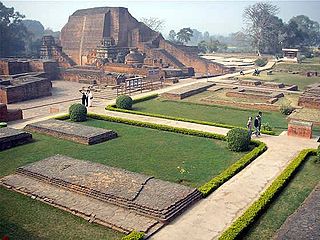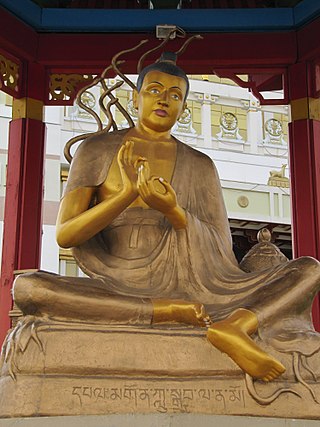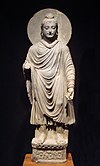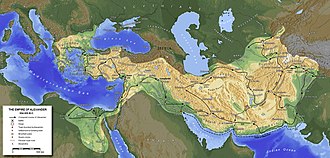
Buddhist philosophy refers to the philosophical investigations and systems of inquiry that developed among various schools of Buddhism in India following the parinirvana of The Buddha and later spread throughout Asia. The Buddhist path combines both philosophical reasoning and meditation. The Buddhist traditions present a multitude of Buddhist paths to liberation, and Buddhist thinkers in India and subsequently in East Asia have covered topics as varied as phenomenology, ethics, ontology, epistemology, logic and philosophy of time in their analysis of these paths.

Nāgārjuna [c. 150 – c. 250 CE (disputed)] was an Indian Mahāyāna Buddhist thinker, scholar-saint and philosopher. He is widely considered one of the most important Buddhist philosophers. Jan Westerhoff considers him to be "one of the greatest thinkers in the history of Asian philosophy."
In the field of epistemology, the problem of the criterion is an issue regarding the starting point of knowledge. This is a separate and more fundamental issue than the regress argument found in discussions on justification of knowledge.

Pyrrho of Elis, born in Elis, Greece, was a Greek philosopher of Classical antiquity, credited as being the first Greek skeptic philosopher and founder of Pyrrhonism.

Arcesilaus was a Greek Hellenistic philosopher. He was the founder of Academic Skepticism and what is variously called the Second or Middle or New Academy – the phase of the Platonic Academy in which it embraced philosophical skepticism.
Aenesidemus was a Greek Pyrrhonist philosopher, born in Knossos on the island of Crete. He lived in the 1st century BC, taught in Alexandria, and flourished shortly after the life of Cicero.

Sextus Empiricus was a Greek Pyrrhonist philosopher and Empiric school physician. His philosophical works are the most complete surviving account of ancient Greek and Roman Pyrrhonism, and because of the arguments they contain against the other Hellenistic philosophies, they are also a major source of information about those philosophies.
Ataraxia is a Greek term first used in Ancient Greek philosophy by Pyrrho and subsequently Epicurus and the Stoics for a lucid state of robust equanimity characterized by ongoing freedom from distress and worry. In non-philosophical usage, the term was used to describe the ideal mental state for soldiers entering battle.

Mādhyamaka, otherwise known as Śūnyavāda and Niḥsvabhāvavāda, refers to a tradition of Buddhist philosophy and practice founded by the Indian Buddhist monk and philosopher Nāgārjuna. The foundational text of the Mādhyamaka tradition is Nāgārjuna's Mūlamadhyamakakārikā. More broadly, Mādhyamaka also refers to the ultimate nature of phenomena as well as the non-conceptual realization of ultimate reality that is experienced in meditation.
The Mūlamadhyamakakārikā, abbreviated as MMK, is the foundational text of the Madhyamaka school of Mahāyāna Buddhist philosophy. It was composed by the Indian philosopher Nāgārjuna.

Timon of Phlius was a Greek Pyrrhonist philosopher, a pupil of Pyrrho, and a celebrated writer of satirical poems called Silloi (Σίλλοι). He was born in Phlius, moved to Megara, and then he returned home and married. He next went to Elis with his wife, and heard Pyrrho, whose tenets he adopted. He also lived on the Hellespont, and taught at Chalcedon, before moving to Athens, where he lived until his death. His writings were said to have been very numerous. He composed poetry, tragedies, satiric dramas, and comedies, of which very little remains. His most famous composition was his Silloi, a satirical account of famous philosophers, living and dead; a spoudaiogeloion in hexameter verse. The Silloi has not survived intact, but it is mentioned and quoted by several ancient authors. It has been suggested that Pyrrhonism ultimately originated with Timon rather than Pyrrho.
Pyrrhonism is a school of philosophical skepticism founded by Pyrrho in the fourth century BCE. It is best known through the surviving works of Sextus Empiricus, writing in the late second century or early third century CE.
The Buddhist doctrine of the two truths differentiates between two levels of satya in the teaching of the Śākyamuni Buddha: the "conventional" or "provisional" (saṁvṛti) truth, and the "ultimate" (paramārtha) truth.
Epoché is an ancient Greek term. In Hellenistic philosophy it is a technical term typically translated as "suspension of judgment" but also as "withholding of assent". In the modern philosophy of Phenomenology it refers to a process of setting aside assumptions and beliefs.

Several instances of interaction between Buddhism and the Roman world are documented by Classical and early Christian writers. Textual sources in Tamil language, moreover, suggest the presence of Buddhism among some Roman citizens in the 2nd century AD.
Aristocles of Messene, in Sicily, was a Peripatetic philosopher, who probably lived in the 1st century AD. He may have been the teacher of Alexander of Aphrodisias.
The tetralemma is a figure that features prominently in the logic of India.
Academic skepticism refers to the skeptical period of ancient Platonism dating from around 266 BCE, when Arcesilaus became scholarch of the Platonic Academy, until around 90 BCE, when Antiochus of Ascalon rejected skepticism, although individual philosophers, such as Favorinus and his teacher Plutarch, continued to defend skepticism after this date. Unlike the existing school of skepticism, the Pyrrhonists, they maintained that knowledge of things is impossible. Ideas or notions are never true; nevertheless, there are degrees of plausibility, and hence degrees of belief, which allow one to act. The school was characterized by its attacks on the Stoics, particularly their dogma that convincing impressions led to true knowledge. The most important Academics were Arcesilaus, Carneades, and Philo of Larissa. The most extensive ancient source of information about Academic skepticism is Academica, written by the Academic skeptic philosopher Cicero.

Buddhist thought and Western philosophy include several parallels.
Ajñāna was one of the nāstika or "heterodox" schools of ancient Indian philosophy, and the ancient school of radical Indian skepticism. It was a Śramaṇa movement and a major rival of early Buddhism, Jainism and the Ājīvika school. They have been recorded in Buddhist and Jain texts. They held that it was impossible to obtain knowledge of metaphysical nature or ascertain the truth value of philosophical propositions; and even if knowledge was possible, it was useless and disadvantageous for final salvation. They were specialized in refutation without propagating any positive doctrine of their own. Sanjaya Belatthiputta was one of the major proponents of this school of thought.











